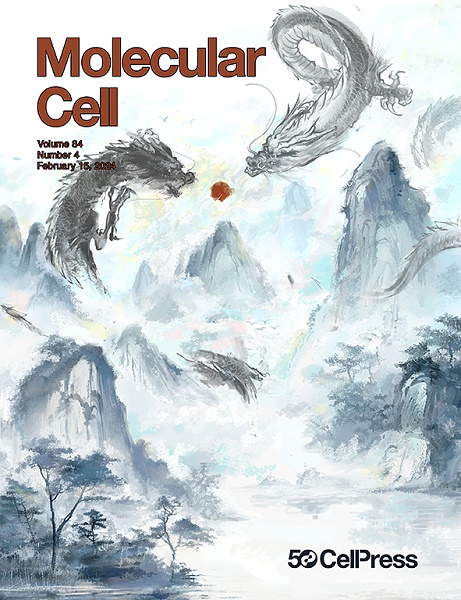ZNF574是缺陷核糖体生物发生中间体的质量控制因子
IF 16.6
1区 生物学
Q1 BIOCHEMISTRY & MOLECULAR BIOLOGY
引用次数: 0
摘要
真核核糖体组装是一个复杂的过程,涉及4种核糖体rna、80种核糖体蛋白和200多种生物发生因子,它们参与了许多相互依存的步骤。这一过程的复杂性和必要性为有害突变的发生、积累和影响下游细胞过程创造了机会。生物发生错误导致的“死端”核糖体中间体迅速降解,证实了监测核糖体组装的质量控制(QC)途径的存在。然而,区分通路和死角中间体的因素尚不清楚。我们设计了一个系统来干扰人类细胞中的核糖体组装,并发现有缺陷的核糖体通过泛素-蛋白酶体系统被降解。我们确定ZNF574是QC途径的关键组成部分,我们称之为核糖体组装监视途径(RASP)。在动物模型中,ZNF574的缺失导致发育缺陷,强调了RASP在机体健康中的重要性。本文章由计算机程序翻译,如有差异,请以英文原文为准。

ZNF574 is a quality control factor for defective ribosome biogenesis intermediates
Eukaryotic ribosome assembly is an intricate process that involves four ribosomal RNAs, 80 ribosomal proteins, and over 200 biogenesis factors that participate in numerous interdependent steps. The complexity and essentiality of this process create opportunities for deleterious mutations to occur, accumulate, and impact downstream cellular processes. “Dead-end” ribosome intermediates that result from biogenesis errors are rapidly degraded, affirming the existence of quality control (QC) pathway(s) that monitor ribosome assembly. However, the factors that differentiate between on-path and dead-end intermediates are unknown. We engineered a system to perturb ribosome assembly in human cells and discovered that faulty ribosomes are degraded via the ubiquitin-proteasome system. We identified ZNF574 as a key component of a QC pathway, which we term the ribosome assembly surveillance pathway (RASP). In an animal model, loss of ZNF574 leads to developmental defects, emphasizing the importance of RASP in organismal health.
求助全文
通过发布文献求助,成功后即可免费获取论文全文。
去求助
来源期刊

Molecular Cell
生物-生化与分子生物学
CiteScore
26.00
自引率
3.80%
发文量
389
审稿时长
1 months
期刊介绍:
Molecular Cell is a companion to Cell, the leading journal of biology and the highest-impact journal in the world. Launched in December 1997 and published monthly. Molecular Cell is dedicated to publishing cutting-edge research in molecular biology, focusing on fundamental cellular processes. The journal encompasses a wide range of topics, including DNA replication, recombination, and repair; Chromatin biology and genome organization; Transcription; RNA processing and decay; Non-coding RNA function; Translation; Protein folding, modification, and quality control; Signal transduction pathways; Cell cycle and checkpoints; Cell death; Autophagy; Metabolism.
 求助内容:
求助内容: 应助结果提醒方式:
应助结果提醒方式:


